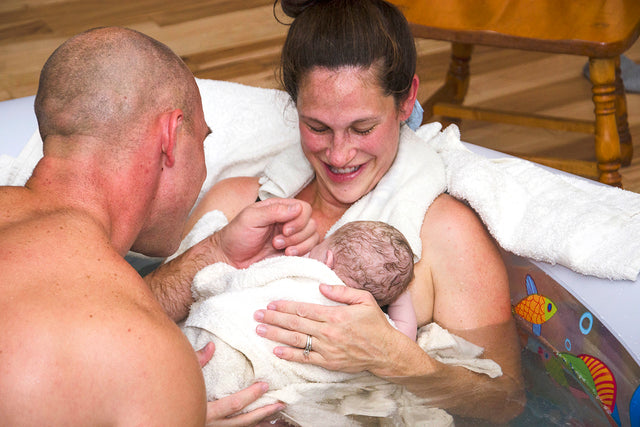Considering Home Birth? Here’s What You Need to Know About Giving Birth at Home

So, you took the test and saw two pink lines. There were probably some shrieks and lots of excited phone calls. It’s not too long after that when women start thinking of baby names, stopping to admire cute onesies, and asking friends what it’s really like to give birth in the hospital…or at home. This is when you might start to wonder if a home birth is right for you.
Are home births safe?
When considering a home birth, the first question that usually pops into a woman’s mind is, “Are home births safe?” Every year, approximately 35,000 US babies are born at home, including all U.S. presidents except for Presidents Clinton, George W. Bush, Obama, and Trump! Most home-birth babies are born safe and healthy.
Which is safer: home birth or hospital birth?
Infant mortality statistics show that planned (not accidental) home births with a registered midwife have about the same rates of fatalities as planned hospital births.
Of course, the big asterisk here is that it takes planning to make sure giving birth at home is as safe as possible. Though the American College of Obstetricians and Gynecologists (ACOG) ultimately believes that a hospital or birth center is the safest place to give birth, the organization does offer guidelines for a safe home birth. These guidelines are based on how much risk is involved to both the mother and the baby.
According to ACOG, a mom who plans on giving birth at home should…
-
Understand the risks associated with home births
-
Use a trained certified nurse-midwife, certified midwife, or midwife whose education and licensure meets the International Confederation of Midwives’ Global Standards for Midwifery Education during home birth
-
Have access to a physician practicing obstetrics within an integrated and regulated health system who is ready to consult
-
Have safe, reliable, and timely transport to a hospital, if complications arise
Is it dangerous to have a home birth—and what are the risks?
Fortunately, today there is only a very low risk associated with childbirth. Some research suggests that home births have fewer maternal interventions than hospital births, however there is also research that shows that home-birth babies experience a higher rate of infant death and seizures than hospital births. ACOG notes that home births have been shown to have twice the risk of infant death and three times the risk of neonatal seizures or serious neurological dysfunction as hospital births.
A well-planned home birth attended by a trained and certified professional can be wonderful, but that doesn’t mean that every expecting mother is a great candidate for a home birth. Women who have any of the following conditions or experiences are NOT ideal candidates for a home birth:
-
Women who are pregnant with multiples
-
Women who have previously had a C-section
-
The baby is in a breech position
-
Women who are diabetic
-
Women who have preeclampsia or toxemia
-
Women who are at risk of preterm labor or who have experienced preterm labor before
What are the benefits of a home birth?
For all the risks involved, which should be taken seriously, there are some benefits that can make a home birth an ideal choice for some mothers.
Benefits of a home birth include:
-
Cost of a home birth: The average home birth may cost one-third to one-half of what a hospital birth costs.
-
Environment. With a home birth, the mother can choose who is present and control the tone. For some expecting moms, low lights and soft music are perfect. For others, being surrounded by friends and family is the way to go.
-
Bonding: The mother and baby are encouraged to immediately bond, without waiting until the umbilical cord has been cut.
How to Plan a Home Birth:
Planning a home birth begins with reading about home births and interviewing 2 to 3 certified midwives. Once you settle on the best person to guide you, next you will want to create a safety plan, carefully planning for an easy birth…and one with complications.
Once all that is done, you can have fun with all the details, like, who to invite, how your home will look and feel, and any traditions you want to include (singing happy birthday when your little one arrives, using a beloved family quilt in the process, etc.)
Here are some steps to take while planning for a safe home birth:
-
Create your support team. This includes hiring a certified midwife and an obstetrician. Both of these professionals should see you during your pregnancy to make sure you are healthy and prepared for a home birth.
-
Put together an emergency birth plan in the event that you need transport to a hospital during labor. This includes how to get there, who takes you, and how to alert your obstetrician.
-
Hire a doula. Doulas are trained to support women going through labor and can help keep you calm, focused, and positive.
-
Find a pediatrician. Ask your midwife and obstetrician to help you find a pediatrician who can see your newborn within 24 hours after birth.
Additionally, you'll want to check to see if there are any additional restrictions or requirements for home births in your state.
Final Thoughts on Home Births
Every mom-to-be should have the birth experience she wants…and if the experience you want is a home birth, just make sure you’re following all of these recommendations to ensure your little bundle has a safe, healthy arrival at home! And no matter where your baby is born, your little one will need a safe place to sleep. Check out SNOO Smart Sleeper—the first baby bed to be granted De Novo authorization for its ability to keep sleeping babies safely on their backs. (Visit happiestbaby.com/fda for important safety information.)